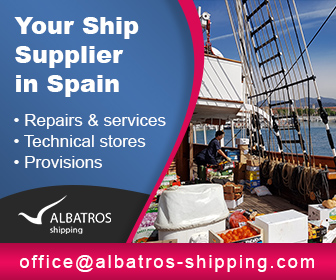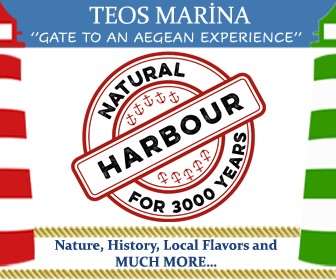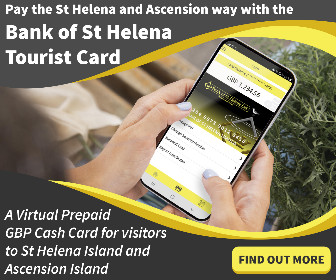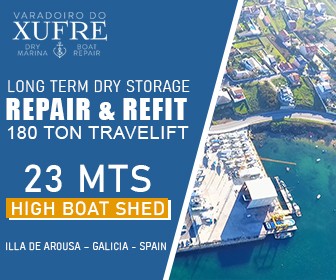UK to Greece: 12 Lessons Learned
With scarcely one year of sailing under their belts and less than 100NM of practical sailing experience in their yacht, New Zealand sailors Connie and Greg Miller sailed away from England in the midst of the COVID pandemic, bound for Greece. In this report Connie details 12 lessons they learned as they sailed across the Bay of Biscay, through the straits of Gibraltar and across the Mediterranean, heading for Greece.
Published 1 year ago
In many respects, passage making is not the joy of sailing. It is a process of travel that gets you to a variety of brochure-pretty destinations for wonderful moments. Sometimes the moments are just like those advertised. Occasionally the moments are wide-eyed terrifying. But we are doing exactly what we said we would do – sailing the seas and inhaling adventure daily. And together we make a great team.
Around 8,000 nautical miles later, we still learn something every single day. Here, we share some of our experiences and learnings that might be helpful for those also planning on sailing the Mediterranean.

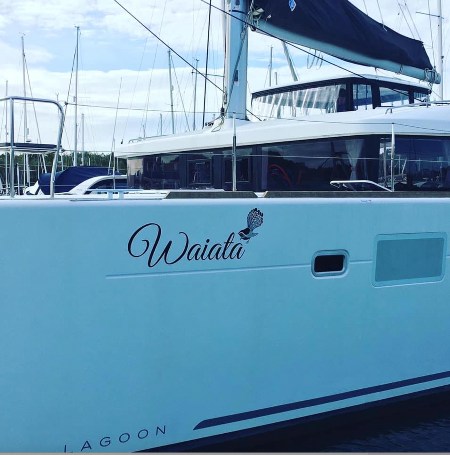
- SV Waiata
Bay of Biscay
The Bay of Biscay is a notorious stretch of water that has a fearsome reputation. Setting off across the English Channel from Cornwall, the last thing we did while we had 4G connection was to download the latest weather. The English Channel is challenging, but the Bay of Biscay is full-face exposed to the Atlantic adventure.
The weather forecast predicted a good safe crossing. But the apparent winds quickly picked up and gusted 15 knots higher than forecast. The seas were bumpy and the currents were strong – against us. We reefed down and oddly took comfort in seeing another boat around our size also making the crossing. They shadowed us and it was great to see them on our AIS each day.
Waiata took a beating with the whipping winds and confused seas, but she was up to the task. We took pleasure in seeing a solo giant sea turtle that passed by our hull; as big as a door, working its way across the bay in its element.

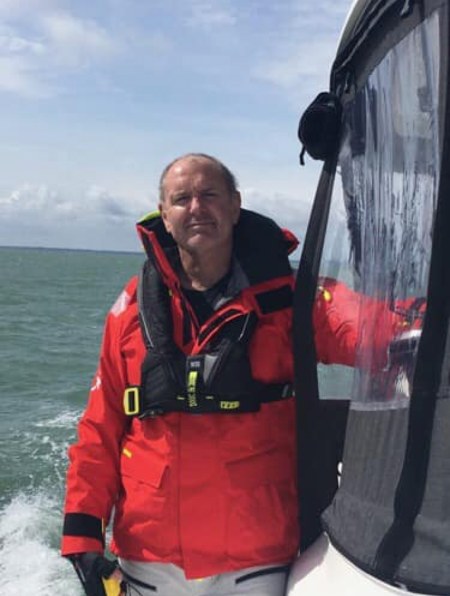
- Captain Greg surveying the seas.
Atlantic Spain
Approaching from the Bay of Biscay, the swell, tidal current and wind can be very challenging and sometimes in conflict with each other, making for a confused sea state.
Atlantic coast days are bookended with vivid red and glowing orange sunrises, through to moon sets. The reason is atmospheric Saharan dust. It is inescapable and you may find that your boat has a pink sheen of dust that settles into every crevice. Get used to it because that little pink dust hangs in the atmosphere and will accompany you for much of your Mediterranean journey.
We did hoist the mainsail on occasion while sailing this coast, usually reefed. We spent 30 percent of this part of our voyage, wing on wing, with our asymmetric and genoa.

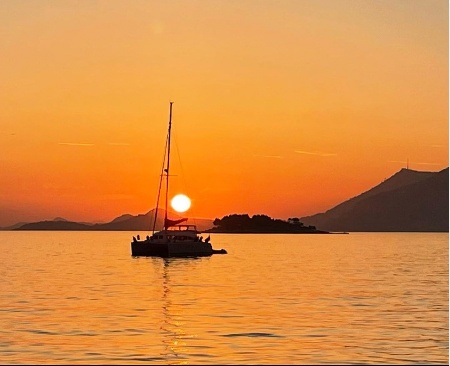
- The sunsets and sunrises are always spectacular.
After a sea-bashing and un-forecast dicey weather conditions, we had to run with the weather away from land for several hours before turning back to our first destination, Finisterre. We spent most of the four-day transit reefed down.
Caution: The coast is liberally littered with fishing pots and fishing boats.
For the first time ever, we raised our yellow ‘Q’ flag and removed our English courtesy flag. It was an oddly satisfying feeling.
- Lesson Number One – Navigational maps are not always correct.
Approaching Finisterre, our B&G chart plotter map (by Navionics), clearly showed we were sailing half a kilometre inland. Head shake moment! We used our monocular, measuring tools and several lighthouse landmarks to ensure we had crossed the Bay of Biscay to the correct destination.
Evidently the maps were wrong, and we advised the providers, so it has now been corrected. If you haven’t updated your maps, beware.
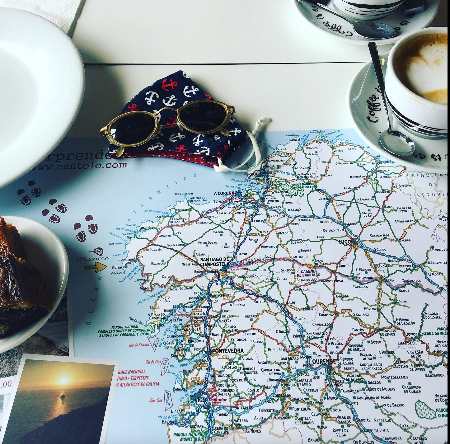
Clearing into Spain and the EU
As a Non-EU boat, on our arrival we tried to officially check in to Spain, but the offices were closed due to Covid. Finisterre has a concrete town quay/Q dock so be sure to put out plenty of fenders as the swell can be substantial and concrete is unforgiving on a hull. There is also a very large bay to anchor in and a selection of nice beaches.
It is worth doing the walk/scooter/bike ride to the huge lighthouse and church at the point. Many who walk the famous ‘Camino de Santiago’, continue here to officially end their pilgrimage. In olden days, this point was considered the end of the known world. Hence the name – Finisterre; meaning Land’s End.
We again attempted to officially check into Spain in Vigo, but they turned us away saying we did not need to check in to Spain at all. Nearby are the ‘Isles of Cies’ (Roman Islands of the Gods). If you’ve come this far you really should visit this stunning piece of the world. You will need to apply for permission to anchor which is easily done online, but be sure to apply before you want to go, not on the day. It is mandatory and you can apply up to 90 days before.
Being acutely aware that we did need to advise customs and immigration authorities somewhere of our formal arrival into Spain and the EU, we tried again much further south in Cadiz.
Southern Spain: Fabulous Cadiz
In Cadiz, the authorities’ offices are easy to find and located on the port waterfront. The biggest challenge was finding someone who speaks English at the Port Authority, Customs and Harbour Master offices.
- Lesson Number Two – A translation app is your friend.
Whilst I do have basic conversational Spanish skills, we managed to communicate clearly thanks to Google Translate. And it works both ways to ensure a clear understanding, which the officials smile at and appreciate. At this point, we officially entered the Mediterranean, getting our boat and passports stamped.
Cadiz is fabulous. There are all manner of boats and even a galleon or two, beautiful expansive bays and it is crammed full of history. The biggest challenge is that there is nowhere that is easy or friendly to tie up your dinghy. It’s not a matter of paying to park your dinghy or not, it is simply unfriendly in a cruising sense in this respect. We were cheeky and tied up out of the way of a fuel dock and climbed a ladder to get to road level.
- Lesson Number Three – Fishing boats are the biggest nightly challenge.
Many fishing boats are manned solo, don’t have AIS and a few scarcely show up on radar. For example, we had a fishing boat pass within 100 metres. Her AIS signal was so weak it only showed up when approximately 200 metres away. We tried contacting them on VHF to confirm port or starboard bow for passing, but they were not contactable. We often shine our torch on our sails to highlight our boat. And naturally, we often change course. Avoidance at all costs.
Gibraltar/La Linea
This is where officially entering the Mediterranean occurs. Timing is critical as the currents are strong. Sailing, Waiata’s hull speed is 10 knots, but we achieved 11 knots SOG.
Our mainsail was hoisted with the first reef for most of this leg.
Note – see Lesson Number One – none of the cardinal markers showing on the charts at Tarifa are there except for the south cardinal marker. We checked our bearing using the Tarifa lighthouse.
If you are a dolphin lover, approaching Gibraltar and La Linea are the places for you. They come from as far as the eye can see, leaping and waving their tails excitedly that there is a new hull to frolic around. There are seven species of dolphin and whale that thrive in these waters. There was of course, some trepidation regarding the potential of Orca’s interfering with our passage. We decided to hug the coast as close as we were comfortable and were lucky. Unfortunately, two other boats that transited in the same direction on the same day as us did not escape Orca attention.
We had booked into Alcaidesa marina. This marina is just on the La Linea (Spanish) side. It is a great location with clean and tidy facilities. However, the finger berths are rather short and a strong current runs through this marina. It is well known by locals, but newbies beware – we damaged our hull trying to moor on our finger berth. The pilings are metal with no protection and our damage was small. Sadly, we watched several other people damage their boats as they entered their berths – one poor guy taking out three other boats as he attempted to berth with the current. The side hustle of boat repairs is surely good for the local economy.

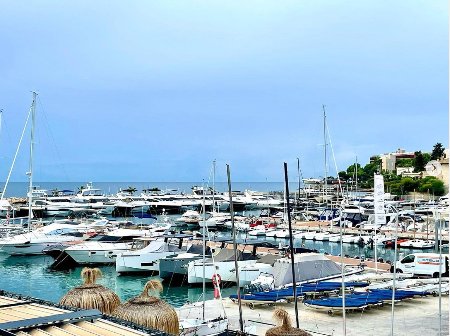
- The marina at Cala Major, Mallorca is fantastic; an easy place to tie up your dinghy.
- Lesson Number Four – It’s OK to wait.
It’s okay to wait to enter a marina until the conditions are suited to your ability and the environment. We did discuss the high winds before entering the marina, but we didn’t know at that time about the current. In hindsight, we should have waited for better conditions by anchoring in La Linea bay. It is a great bay with excellent holding.
Access to Gibraltar is easy and fun. In some respects, it was like returning to England from where we had sailed only a month before. Do go to the ‘Top of the Rock’ – you’ll certainly be able to see your boat whether it’s anchored or in a marina. Do beware of the cute monkeys who will want to steal your sandwiches and be sure to have an English ale once you’ve conquered the mount and descended.
Topping up your diesel here is tax free, irrespective of whether you have stayed on Spanish La Linea or English Gibraltar side. The Gibraltar fuel dock is signed ‘CEPSA’, it’s very easy to access and easy to dock. Bonus points as they certainly have the most helpful guys to help you tie off when you dock for fuel too.
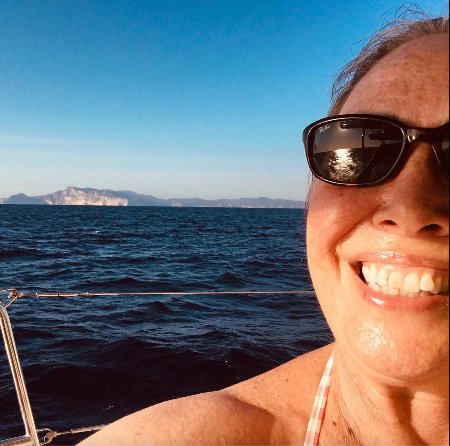

Balearics – Formentera and Mallorca
We departed Gibraltar with the first reef in the main and the genoa out, with 30 plus knot gusts behind and a reasonable sea state. We often found the weather forecasts were short by half, meaning if the forecast was for 10 knots gusting 15, we regularly found we had 20 plus knots gusting 30.
- Lesson Number Five – Plus 10 to the Wind.
Everywhere in the Mediterranean it pays to ‘plus 10’ to the wind and gust forecasts. Wind quickly affects sea state and we found forecasted un-27 knot winds with 2.5 metre swells at 3 second intervals, meaning we had to turn away and take refuge on the coast.
Marine traffic on this leg is mostly tankers, an occasional cruise liner, and the perpetual presence of fishing boats. Most have AIS.
Formentera is the tiniest of the Balearics and a picture postcard place – white sanded, azure hued water. Be sure NOT to anchor in the Poseidon grass prairies as that will earn you a fine. The water clarity is world class, and you will find good holding in the sand. At night it is a peaceful, gorgeous place as the day trippers leave. By day, it is bonkers, jam-packed and slightly dangerous. Day sailors whizz around at high speed and squeeze themselves behind boats even with less than 10 metres between the back of your boat and the swimming buoys. A plethora of speed boats rip through the anchorage creating large wakes so be sure that you have everything battened down, including your cocktail glasses. But it is a gobsmacking, stunning, must-see spot. Ibiza is just a short ferry ride away, but for us, Formentera is the starring sister of these islands.
After a two day sail, we had our first experience of smelling the approach of land.
Mallorca smells of pineapple, coconut and sunscreen, and cruise ships lit up like sailing cities arrive by the dozen. Our chosen anchorage in Palma was Cala Major. We arrived at dawn to find a machine-gun-bearing military ship lifting its anchor. Cala Major is an anchorage under the King of Spain’s family summer palace. For the entirety of our weeklong stay, there was protection in the form of a guard, and good weather protection too.
Besides a couple of large quality hotels, the bay brags white beaches, crystal waters, natural rock pools and grottos. The excellent marina permits you to leave your dinghy there too. Some people have said there is a small charge to leave your dinghy, but we have always gone to the marina office, and they have kindly never charged us for the privilege of parking there.
Irrespective, it’s a great location, a short cheap bus ride to the centre of Palma (2 Euros), and there is a supermarket about 400 metres away. Near the market, on the roadside are recycling and rubbish receptacles.
We had a false start leaving Mallorca. With 18 knot winds just 12 hours into our passage to Sardinia there was a huge BANG, and our starboard shroud went slack. We decided it was safest to return to Mallorca where we knew there was great technical support. We waited a week for two technicians to come with their enormous wrenches and technical know-how. Almost everyone said ‘the problem is your bulkheads’. Incorrect!
- Lesson Number Six – Get Your Rigging Tension Checked.
Because our boat was only two years old when we bought her, she had not had her ‘running in’ service. All sailing boats should be checked and re-tensioned after their first year or two. The technicians made a couple of turns on the stays, checked the rake of the mast, and said some lovely things about our boat. She has not complained since she had her ‘check-up’ and now sails better than ever.
Italy – Sardinia and Sicily
Whilst officially part of Italy, Sardinia is in actuality closer to Tunisia than it is to Rome. We had flights to make to New Zealand and the Covid-19 MIQ situation meant we had to pass by Italy as fast as we could.
It was a two-day non-stop sail between the Balearic Islands and Sardinia. We used our entire sail wardrobe when we had good winds. But around halfway across, we noticed that one of the mainsail battens had partly worked its way out. We had lost a batten plug somewhere along the way and it was not to be found anywhere.
- Lesson Number Seven – Check your sails (and the tell-tales too!).
Closer inspection showed that several other batten plugs were also loose. We removed the batten, tightened any offending loose ones, and took a reef to get as tight a sail as we could with the missing batten.
Once we reached Sardinia, we contacted the local dealer. They had just ONE batten plug in stock and we can’t rave enough about our positive experience. The exceptional dealer named Carlos, was in the north at Porto Karalis, and we were in the south (Cagliari to be exact). In an extreme example of excellent customer service, one of the technician’s friends personally drove the length of Sardinia to hand-deliver the plug to us for $50. He probably spent that amount in gas!
Sardinia
Sardinia is a stunning location. The waters are turquoise, the beach sand icing-sugar white and the free anchorages are postcard pretty. It is a place to take your time and inhale. Our chosen anchorage for the weekend was Porto Pino, anchored in five metres of sand. We collected our batten plug from our personal courier on Monday morning, installed the plug, hoisted the mainsail, and within minutes we set off to Sicily bragging a fully battened mainsail.
Sicily
We sailed along the south Sicilian coast with the first reef in our main on our way east. We passed oil rigs lit up like cities at sea, and otherwise not a lot of traffic apart from the occasional fishing boat, cruise ship or tanker.
There is an amazing anchorage along the southern coast where you can anchor directly in front of the stunning ‘Archeologico de Selinunte’. It is the largest archaeological park in Europe, with temples and remnants of a 7th century BC settlement. We stopped for one night in a choppy sea state, slept, then kept going.
We found the 4G along the Sicilian coast sadly wanting. Once we obtained an albeit poor internet connection, we managed to download the weather which was depressing. But as is usual in the Mediterranean, you don’t always get the postcard sailing they show you in the brochure. At this point, our sailing boat was being used more as a motorboat. And the weather was requiring us to amp up to our wet weather wardrobe.
- Lesson Number Eight – Using the “Iron Sails”.
You will use your iron sails (i.e. motor) more than you think you will. We were scarcely making any ground toward our anchorage and had to motor the last 90 nautical miles to Porto Palo. We had to motor far more than we ever imagined. “Sail the Med” they said! But you will need to use your engine to get to where you want more often than you think, or you’ll be going nowhere.
It’s feast or famine in the wind stakes. Porto Palo is the southernmost eastern point of Sicily and we got stuck there for an entire week waiting for a weather window. Porto Palo has a safe walled lagoon, but it’s water we wouldn’t swim in. Make water before you go in! It is not pretty but it is pretty safe. There is a supermarket around 1.5 km walk away. Otherwise, it is simply a waiting stop.
The Greek Islands
For many, the Greek Islands are a paradise cruising destination. With over 6,000 islands and six main island groups, island hopping is easy and there is certainly something to suit everyone. Greek history spans all of time. The people are charming, the beaches unspoiled and the cuisine is delicious.
On our sail to Greece, we were bounced around like a ping pong ball. We saw waterspouts form before our very eyes. Squalls came up suddenly. We dropped and furled our sails and turned both engines on. Lightning and thunder ensued and even with both of our engines at full revs we were scarcely holding ground. It was terrifying.
- Lesson Number Nine – Dodging the Bad Weather.
You can dodge bad weather if you have radar. Most boats have radar and we have learned to use ours as part of our weather management when underway. Not long after the waterspouts were forming, we saw a growing rash of red on our navigation screen. It showed us in real time, that a lightning and thunderstorm was enveloping us from every angle. Full marks to the Captain as he weaved us through the narrow breaks as they occurred. Even a tanker that could see us on radar called over the radio to check if we were alright. It was an eight hour fight against the weather. We emerged unscathed and with increased confidence that our catamaran was up to the challenge, wherever we choose to sail her.
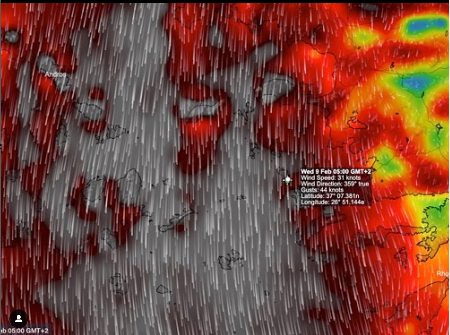

Peloponnese – Kalamata
Irrespective of where you check in to Greece, you need to have official papers if you are non-EU. You must pay the cruising tax, online, before entering Greek waters. The office where you first check in will provide you with a transit log that you must maintain and use to check in at each port. It sounds arduous. It’s not. The people at the offices we encountered were always very nice. Bonus: they have a far better command of English than we do of Greek. It’s always good to have learned the basics though; kalimera for ‘good morning’ and kalispera for ‘good afternoon’. See Lesson Number Two – a translation app is your friend.
After the storm, we officially checked into mainland Greece in Kalamata. Famous for its meaty olives, it is a very long sail down the bay but worth it. There is a large town quay behind a sea wall offering easy access to the immigration and customs offices.
- Lesson Number 10: Pay only when due.
Beware that Tepai (cruising tax) works on the calendar month, so if you check in on 25th you will have to pay the full month’s whack of money again in say, six days’ time. If possible, save your arrival for the first of the month. We made the error of paying six months’ worth of Tepai at once. This was because we were flying back to New Zealand and thought we were being efficient. We were not!
The Greek government also changed the rules during our time there and decided that even if your boat was in a marina and you had handed in your papers while overseas, you are deemed to be ‘cruising’. Henceforth, now only boats on the hard do not pay Tepai. You will not be refunded any over payment. The payments for the month’s not used will not be credited to future months of tepai tax. This is simply the way it is. We just smiled and considered it a donation to the government.
Free Anchorages
In Greece you are spoilt for choice with the selection of free anchorages. Each one offers jaw dropping views, tiny churches perched on little ledges, traditional tavernas, history and mythical stories about Greek Gods. Many towns have a free or cheap town quay meaning access to the traditional charm of village life is easily accessible.
Limeni (south of Kalamata) is lovely. Charming, peaceful, and surrounded by mountains that are lit at night. Dorou Bay is next door, and famous for its neolithic caves which are worthy of a visit.
Elafonisos is a visual pleasure.
Rounding Akra Malea it is said you need to double your wind and wave height expectations from the forecast. A tiny old monastery clings to this peninsula where monks were once the coast watchers.
We certainly experienced large swells and choppy seas most days. And the north wind blew strong for days on end. The ancient Greeks called these winds the Etesian winds. They are katabatic and we felt their effect to the point where we worried about our safety. We learnt very quickly to be wary of the Meltemi.

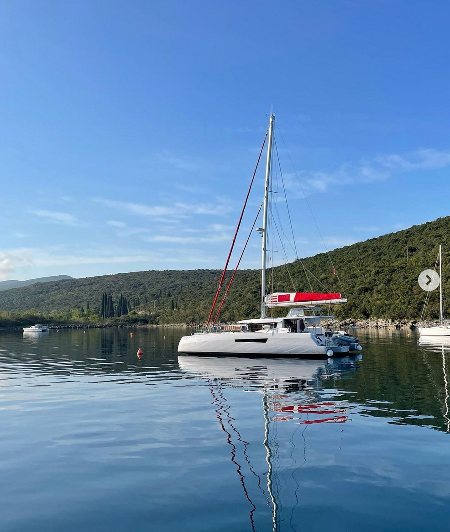
- A quiet anchorage.
- Lesson Number 11 – Beware the Meltemi
The Meltemi is a dastardly wind for sailors. It can start blowing with little or no warning and can blow for days. Helpful clues for sailors that a Meltemi is coming include a drop in humidity and the presence of altocumulus clouds. These winds usually blow between May and October. And the chances are, you’re going to encounter them. Our recommendation, in spring anyway when we sailed through, would be to sail with at least your first reef. We went to a second reef several times on this transit.
Cyclades – Milos
We arrived at Milos in the dark after a challenging sail due to, you guessed it, huge winds! Milos is a very protected and large bay. There is plenty of room for anchoring and the preferred side would be to the port side as you arrive. The office to check in with your transit log is in town, a few steps up from the marine parade and clearly signposted. It’s an easy place to tie up your dinghy and wander around. Supermarkets, bakeries, everything you need is right here, where the Venus de Milo was found. We stayed several days but had to get on.
We were racing against time and sailed day and night. The thing about night sailing is that the wind seemed more favourable and we made good SOG under full sail in the dark. The Meltemi seems to come up in the morning along with the sun rise.
A couple of times we found a protected bay to bank some sleep. One memorable bay was between two Greek islands with scarcely a river of water separating them. We were surrounded by mountains and a little absurdly, there was a beach bar but nothing else … except for a family of goats. Greek sun rises are magical, and as the sun rose, we lifted the anchor and unfurled the genoa on a starboard tack. We had 50 nm to go.
Racing to Leros
We were racing to Lakki Marina in Leros. Leros is located just 20 nm from Turkey in the Dodecanese, but we had doubts that the wind and weather conditions would allow us to make the distance in time. We decided to burn the diesel and motor sail.
We had many flights to get home and we were due to depart in just a couple of days. Missing flights was not an option because New Zealand’s MIQ Covid isolation process was so stringent. We needed to get home for our daughter’s wedding. And we needed to bed our boat down before we flew.

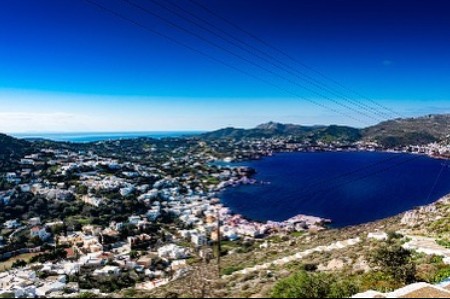
- A beautiful almost heart-shaped bay, Lakki, Leros Island, Greece.
Land ahoy!
Once we could see Leros we were confident we would make it – 23 nautical miles out, we could see the island. So, with both engines on, we radioed the Lakki marina office. They had been expecting us and sent out a tender with two men to help us into our marina berth, tying Waiata down and putting her to bed for winter and the next four months.
- Lesson Number 12 – Experience is the best teacher.
It’s hard to believe that we have done all this. That we have experienced and seen such beautiful parts of the world and drunk in the visual book-ending of days with sunrises and sunsets. That we have achieved our goal of buying a boat and adventured all the way from England to the far-flung side of Greece, with so little experience. It is true that experience is the best teacher. We have learned so much and continue to learn something every day.
But now we must fly with a family wedding to get to, and friends to reconnect with. When we return to Waiata, we will sail north through Greece, to Montenegro, Croatia, Italy, France, and Spain which we will share with you next time.
Connie and Greg
SV Sailing Waiata
………………………………………………………………………………………………………………………………………….
About Sailing Waiata and her Crew
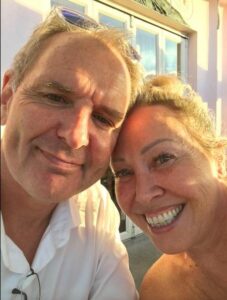

With scarcely one year of sailing and less than 100 nm of practical sailing experience, they sailed away from England, letting the lines go in July 2021. Setting off across the English Channel and the Bay of Biscay, was according to Connie, a little intimidating and scary. They skipped France due to Covid regulations and sailed day and night directly to Spain and beyond.
They sailed the Mediterranean during Spring, Summer and Autumn and wintered Waiata in a marina in Leros, in the Greek Islands.
Follow their adventures at:
………………………………………………………………………………………………………………………………………
The opinions expressed in this article are the author’s own and do not reflect the view of Noonsite.com or World Cruising Club.
………………………………………………………………………………………………………………………………………
Find out all news, reports, links and comments posted on Noonsite, plus cruising information from around the world, by subscribing to our FREE monthly newsletter. Go to https://www.noonsite.com/newsletter/.
Related to following destinations: Balearics, Dodecanese, Formentera, Gibraltar, Greece, Italy, Kalamata, Leros, Peloponnese, Sardinia, Sicily, Spain, Turkey
Related to the following Cruising Resources: Cruising Information, Liveaboard Tips, Mediterranean, Routing

